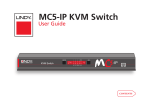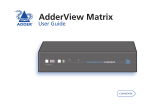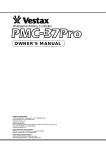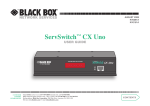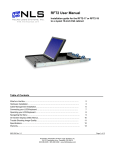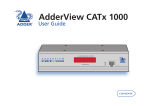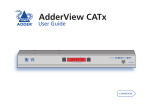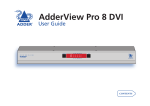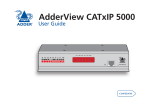Download ADDER AdderView CATxIP 000 User manual
Transcript
Full User Manual for products ending in CAT5A or CAT5AS Sept. 1, 2009 Contents Introduction Installation Connections.................................................................................................................5 Remote user (via X100/X200 extender).......................................................5 Computer system (via CAM)............................................................................5 Cascading multiple units..................................................................................6 Connecting units in cascade.....................................................................6 Addressing computers in a cascade.......................................................6 Using cascaded computers........................................................................6 Configuration Overall initial configuration ..................................................................................7 Configuration menus................................................................................................8 Configuration menus layout............................................................................9 General security and configuration steps.........................................................9 Registering users (edit user list)......................................................................... 10 Registering computers (edit computer list).................................................. 11 Autoscanning........................................................................................................... 12 Operation Local and remote user access............................................................................. 13 Selecting a computer...................................................................................... 13 Logging in and out........................................................................................... 15 Selecting cascaded computers.................................................................... 16 The confirmation box...................................................................................... 16 The reminder banner....................................................................................... 16 Power switching (via configuration menu)............................................. 17 User preferences and functions................................................................... 17 Further information Appendix 1 – Configuration menus................................................................. 18 Functions............................................................................................................. 19 User Preferences................................................................................................ 19 Global Preferences............................................................................................ 20 Setup Options.................................................................................................... 21 Advanced Options............................................................................................ 22 Safety information.................................................................................................. 24 Radio Frequency Energy....................................................................................... 24 Introduction Thank you for choosing the Neuro Logic Systems’ NetCom product line featuring the AdderView CATx 1000 from Adder Technology. This unit has been created to allow a single operator to take full control of many computer systems. This unit takes full advantage of category 5, 5e or 6 structured cabling to provide flexible installation and configuration. Every connected computer can be up to 10m (32 feet) from the NetCom, linked by a standard CATx cable and the ingenious CAM (Computer Access Module). The user can located directly at the NetCom unit or placed up to 300m (980 feet) away using either Adder X100 or X200 extenders and, once again, standard CATx cabling This manual will deal with the functionality of the AdderView CATx 1000 which is the KVM switch integrated into the NetCom product line. Computer Access Modules One required per connected computer. There are five different formats, depending on the required computer connections: Note: CAMs derive power from the computer system via either the PS/2-style keyboard connector, USB or SUN connector. PS/2-style Connectors:Analog video, PS/2-style keyboard and PS/2-style mouse. Part number: CATX-PS2 Green indicator - power present PS/2-style with audio Connectors:Analog video, PS/2-style keyboard, PS/2-style mouse and 3.5mm audio jack. Part number: CATX-PS2A Yellow indicator - signal activity USB Connectors:Analog video and USB keyboard/mouse. Part number: CATX-USB Computer Access Module USB with audio Connectors:Analog video, USB keyboard/mouse and 3.5mm audio jack. Part number: CATX-USBA Sun with audio Connectors:Analog video, Sun keyboard/mouse and 3.5mm audio jack. Part number: CATX-SUNA A range of different connector combinations are made available across the five CAM formats Category 5, 5e or 6 cable to CAM Note: Each CAM is specifically shaped so that it can be secured using a cable tie around its middle. In this way, two CAMs can also be neatly joined together, back-to-back. USB keyboard/mouse Sun keyboard/mouse PS/2-style mouse PS/2-style keyboard Audio Video Remote user port This port can either be used to connect a single remote user (with an optional X100 or X200 extender module) at a distance of up to 300m or used to connect other AdderView CATx 1000 units in cascade. IMPORTANT: This is not an Ethernet port and must not be connected to any network. Computer ports Each computer connects to one of these ports via standard category 5, 5e or 6 cabling. At the other end of the cabling a CAM (Computer Access Module) is used to provide the necessary keyboard, video, mouse and optional speaker connections. Cascading multiple units The AdderView CATx 1000 units support up to sixteen directly connected computer systems, however, this is by no means the limit. Instead of connecting computers to every output port, you can instead link other AdderView CATx 1000 units. Thus each output of the original AdderView CATx 1000 unit can link through to many more computers connected to the secondary units. Maximum number of computer supported is 512. The combination of AdderView CATx 1000 units can be arranged two levels deep forming a tree, or cascade arrangement, with computer systems situated at either level within that cascade tree. Connecting units in cascade The method for cascading AdderView CATx 1000 units is straightforward and requires no hardware settings or lengthy configuration process. The method of linking AdderView CATx 1000 units is the same regardless of the cascade level, or number of devices attached. Put simply: • A single cascade link is made by connecting a computer connections socket of one unit to the REMOTE user port socket of the unit below it. Please consider the following when making cascade connections between AdderView CATx 1000 units. Tips for successful cascading • The maximum number of levels for a cascade is two. • For each cascade link, use a standard category 5, 5e or 6 twisted-pair cable, terminated at each end with an RJ45 connector. There must be no crossover connections within the cable. The cascade link cables can be up to 50m (160 feet) in length. However, remember that the overall length between the remote user (via an X100 or X200 extender) and any computer (via a CAM) must not exceed 300m (980 feet) - that figure includes the cascade link cables. Also ensure that the total length from the top AdderView CATx 1000 to any CAM does not exceed 10m. • The procedure given opposite may be carried out in any order but for clarity the instruction will begin at the higher level AdderView CATx 1000 unit (here called the upper unit), i.e. the one that is being fed into by a unit at the cascade level below (here called the lower unit). The procedure remains the same regardless of exactly which cascade levels are being connected. The basic rule is that each link is made by connecting a computer connectionS port of the upper switch to a CATx user portS of the lower switch. To connect units in cascade 1 Ensure that power is disconnected from the AdderView CATx 1000 and all other units to be connected. 2 Connect one end of the cascade link cable to an appropriate COMPUTER CONNECTIONS port on the rear panel of the upper unit. 3 Connect the other end of the cascade link cable to the remote user RJ45 socket on the front panel of the lower unit. 4 Repeat steps 2 and 3 for the cascade links between each AdderView CATx 1000 unit. Once the AdderView CATx 1000 units and computers have been connected, you can edit their names to make it much easier to locate them. See the To create/edit computer names section in the Configuration chapter for more details. Addressing computers in a cascade Computer systems connected within a cascade arrangement are addressed using up to four digits, two for each cascade level. The pairs of digits specify which of the COMPUTER CONNECTIONS ports on each of the AdderView CATx 1000 units must be enabled to reach a specific computer. In the diagram given here, a portion of the previous cascade diagram indicates how the routes to two particular computers are formed and addressed. Each cascade level requires two digits, hence the computer marked in red requires a longer address (1203) as it is situated at cascade level 2, compared to the blue computer at the top level with its two digit port number. The first time that you make a connection between two AdderView CATx 1000 units, the master unit will detect this and ask (via the on screen menu) if you want to automatically add computers. If you choose ‘Yes’ then the ports on the cascade will be automatically added to the on screen menu. Using cascaded computers In use, cascaded computers can be accessed using exactly the same methods as for those connected directly to the AdderView CATx 1000. However, by far the easiest way is to use the on screen menu. This is because it displays the computer names and does not require any knowledge of port addresses. See the Selecting cascaded computers section in the Operation chapter for more details. Configuration Almost all configuration and operational aspects of the AdderView CATx 1000 units are controlled via on-screen menu displays. Overall initial configuration When setting up a new installation, the following stages are recommended: 1 Enable the general ‘Security’ option. With security disabled (default setting), a local or remote user attached to the AdderView CATx 1000 will have full and unrestricted access to all computers and all AdderView CATx 1000 settings. In larger installations, you are strongly recommended to enable security and set up individual user accounts with access privileges. 2 Create an ADMIN (administration) password. All AdderView CATx 1000 units have a fixed user account that cannot be deleted or renamed, called ADMIN. This user account is the only one that is able to make important system changes. If you intend to use security, then it is important to allocate a password to the ADMIN account. 3 Create user accounts and allocate access rights. Use the ADMIN account to add user profiles, passwords and access rights for each of the system users. 4 Provide names for computers. When numerous computers are attached, you are strongly advised to provide names for each, to assist with recognition. 5 Configure the required ‘Setup Options’ and ‘Global Preferences’ Use the ADMIN account to determine key AdderView CATx 1000 settings and timing characteristics. Configuration menus The configuration menus allow you to determine many aspects of the AdderView CATx 1000 capabilities. From here you can: • Create individual user accounts and determine access rights, • Provide names for all connected computers to allow quick recognition, • Set individual and global settings for users, • Run various functions, such as mouse restore operation, • Save and load AdderView CATx 1000 configuration settings, and more. To access the configuration menu 1 If the main menu is not already displayed, press and hold and then press using a keyboard attached to a AdderView CATx 1000 user port. The main menu will be displayed: ADDERVIEW CATx 1000 Computer Port Computer 1 01 Computer 2 02 Computer 3 03 Computer 4 04 Computer 5 05 Computer 6 06 Computer 7 07 Computer 8 08 User Status ADMIN SHARED USE F1-More menus F3-Find Esc-Quit F4-Logout Default names for each computer port Your Login name 2 Press Availability of each computer: Green - available Red - unavailable Port numbers Hotkeys Note: and are the standard hotkeys and can be altered to avoid clashes with other devices or software. If you change the hotkeys, remember to use the new ones in place of and when following the instructions in this guide. Security Note: If the security option has been enabled, you will be asked for a valid user name and password before the main menu can be displayed. ADDERVIEW CATx 1000 User Name: Password: Esc-Scr Save IMPORTANT: When supplied, AdderView CATx 1000 units have their security features disabled, which means that any attached users have access to all connected computers and all AdderView CATx 1000 settings. You are strongly recommended to enable the ‘Security’ feature and set an access password for the ADMIN account. Connection status Assistance for keypress options To display the Configuration Menu: ADDERVIEW CATx 1000 Configuration Menu Functions User Preferences Global Preferences Setup Options Edit Computer List Edit User List Edit Autoscan List F1-More menus Enter-Select Esc-Quit Firmware Version 1.01b06 3 Use the and keys to highlight an option, then press to select. Configuration menus layout The menu options are arranged as shown here: Configuration Menu Functions Restore Standard Mouse Restore Intellimouse Power Control Clear UTP Extender Password Reset to Factory Defaults Send Data to RS232 port Read Data from RS232 port User Preferences OSD Colour Reminder Banner Reminder Colour Screen Saver Type Confirmation Box Global Preferences Mouse Switching Screen Saver Autoscan Mode Autoscan Period OSD Dwell Time User Timeout Setup Options Security Language Hotkeys Automatic Logout Audio Add Computers Edit Computer List Edit User List Edit Autoscan List (F1) Advanced Options DDC Options Power Control USB Country Code For a description of each option within the Configuration menus, see Appendix 1 for more details. General security and configuration steps To enable general security 1 Display the Configuration menu. 2 Highlight ‘Setup Options’ and press . to select ‘ENABLED’. 3 Highlight ‘Security’ and press 4 Now create a new password for the ADMIN user account. To set an ADMIN password 1 Display the Configuration menu. . 2 Highlight ‘Edit User List’ and press 3 Highlight ‘ADMIN’ and press . Press again to accept the name ‘ADMIN’ without change. 4 Enter an appropriate password for the ADMIN user account with regard to the following: • The password can be up to 12 characters long. • The password can use letters, numerals and/or certain punctuation marks. • The password is not case sensitive. 5 Press . The ‘Edit Access Rights’ menu will be displayed. However, as the ADMIN account always has access to all computers, press again to save the new password. What to do if the ADMIN password has been forgotten. To change the hotkeys AdderView CATx 1000 units use and as their standard hotkeys. These can be changed if they clash with other software or hardware within the installation. 1 Display the Configuration menu. 2 Highlight ‘Setup Options’ and press . 3 Highlight ‘Hotkeys’ and press to select the required hotkey combination. The options are: CRTL+ALT, CTRL+SHIFT, ALT+SHIFT, ALT GR, LEFT ALT+RIGHT ALT, LEFT CTRL+LEFT ALT or RIGHT CTRL+RIGHT ALT. 4 Press to return to the ‘Configuration Menu’. Registering users (edit user list) To create/edit user accounts 1 Display the Configuration menu. Note: You must be logged-in as the ADMIN user. . 2 Highlight ‘Edit User List’ and press ADDERVIEW CATx 1000 Edit User List admin Sam Oliver Johnny Ins-Add F1-Clone -Select Esc-Quit Del-Delete Enter-Edit 3 Either: , or • Create a new account - Press , enter a new user name and press • Edit an existing account - Highlight the required user name and press Edit the name, if appropriate, and/or press . 4 Enter or edit the password with regard to the following: • The password can be up to 12 characters long. • The password can use letters, numerals and/or certain punctuation marks. • The password field can remain blank to allow open access to this account. 5 Press to display the ‘Edit Access Rights’ menu. Here you can determine which of the connected computers can be accessed by the selected user account. Only computers that show the ‘+’ marker to ADDERVIEW CATx 1000 Edit Autoscan List Computer 1 01 Computer 2 02 Computer 3 03 Computer 4 04 Computer 5 05 Computer 6 06 Computer 7 07 Computer 8 08 Space-Toggle Enter-Save F1-All F2-None F3-Find Esc-Quit + + + + + + + + Cross markers indicate which computers will be accessible to the currently selected user. To change the permission state: Highlight a computer and press the space bar. the right of the menu box will be accessible to the user account. Note: Access rights for user accounts to particular computers can also be controlled from the ‘Edit Computer List’ menu. 6 Select and deselect computers as follows: • Individual computer - Highlight a computer name, then press to apply, or remove, a ‘+’ marker. • Access to all computers – Press • Access to no computers – Press 7 When all settings have been made, press to save and exit. Press to return to the ‘Configuration Menu’. Registering computers (edit computer list) To create/edit computer entries 1 Display the Configuration menu. Note: You must be logged-in as the ADMIN user. 2 Highlight ‘Edit Computer List’ and press . ADDERVIEW CATx 1000 Edit Computer List Computer 1 01 Computer 2 02 Computer 3 03 Computer 4 04 Computer 5 05 Computer 6 06 Computer 7 12 Computer 8 0803 Ins-Add Del-Delete F1-Clone Enter-Edit -Select F3-Find Esc-Quit 3 Either: and enter a new name, or • Create a new computer entry – Press • Edit an existing computer entry – Highlight a computer name and press . Press (Backspace) to delete existing characters and enter the required new name (up to 16 characters). Note: Avoid creating two names for the same computer port. 4 Press and the cursor will move to the computer port column on the right side. Change or enter the port address of the computer as required. See the Addressing computers in a cascade section for more details. 5 When the port address is complete, press will be displayed. ADDERVIEW CATx 1000 Edit access rights admin Sam Oliver Johnny Space-Toggle F1-All Esc-Quit + + + . The ‘Edit access rights’ menu Cross markers indicate which users will be granted access to the currently selected computer. To change the permission state: Highlight a user name and press the space bar. Enter-Save F2-None F3-Find Here you can determine which users should have access to the created/ edited computer. Only users that show a ‘+’ marker to the right of the menu box will be granted access to the computer. Note: Access rights for particular user accounts to computers can also be controlled from the ‘Edit User List’ menu 6 Select and deselect users as follows: • Individual user - Highlight a user name, then press to apply, or remove, the ‘+’ marker. • Allow access for all users – Press • Allow no user access (except ADMIN) – Press 6 When all settings have been made, press to save and exit. Press to return to the ‘Configuration Menu’. 10 Autoscanning The AdderView CATx 1000 provides an autoscan mode that switches between the connected computers in sequence. This mode is useful to allow users and administrators to sample activity among the connected machines. Three scanning modes are provided: • Scan list – Only computers declared within an autoscan list will be viewed. Computers connected to cascaded switches can be included in the autoscan list. • Active PCs – Only computer ports where an active computer is detected will be viewed. This mode avoids blank screens from being displayed and helps to prevent the viewing monitor from entering a power-down state on every scan cycle. Computers connected to cascaded switches will not be viewed in this mode. • All PCs – This mode visits, in turn, each computer that is connected directly to the AdderView CATx 1000. This mode should be used with care due to the reasons given in the warning below. Computers connected to cascaded switches will not be viewed in this mode. The scanning mode is a global setting and hence will be the one viewed by any user who selects on their keyboard. Note, however, that users will only see the scanned computers to which they have access rights. WARNING: Many monitors are fitted with automatic power saving relays that switch off after a few seconds when connected to an inactive computer. If you are using such a monitor, do not set the AdderView CATx 1000 to the scan ‘ALL PCs’ mode. Continual switching on and off of the monitor’s relay will eventually damage the monitor. If using such a monitor in conjunction with the ‘Scan List’ option, ensure that all selected computers are active. There are up to three steps that need to be configured to use autoscanning: • Select the autoscan mode: Scan List, Active PCs or All PCs. • Select the autoscan period. This is the time that is spent viewing each computer. This step also enables and disables the autoscan feature. • Define the autoscan list. This step is only required when the Scan List option is selected and allows you to select which computers will be scanned. To select an autoscan mode 1 Display the Configuration menu. Note: You must be logged-in as the ADMIN user. 2 Highlight ‘Global Preferences’ and press . until the required option is 3 Highlight ‘Autoscan Mode’ and press displayed: SCAN LIST, ACTIVE PCs or ALL PCs. To select an autoscan period 1 Display the Configuration menu. Note: You must be logged-in as the ADMIN user. 2 Highlight ‘Global Preferences’ and press . 3 Highlight ‘Autoscan Period’ and press until the required time to view each computer is displayed, ranging from 2 seconds to 5 minutes. To define an autoscan list Note: This stage is required only when the ‘Scan List’ autoscan mode is selected. 1 Display the Configuration menu. Note: You must be logged-in as the ADMIN user. . A list of all connected computers 2 Highlight ‘Edit Autoscan List’ and press will be displayed. Only computers that show a ‘+’ marker to the right of the menu box will be autoscanned. 3 Select and deselect computers to scan as follows: • Individual computer - Highlight a computer name, then press to apply, or remove, the ‘+’ marker. • Mark all computers for scanning – Press . • Unmark all computers – Press . 4 When all settings have been made, press to save and exit. Press to return to the ‘Configuration Menu’. To view autoscan • At one of the user ports, press . Note: and are the standard hotkeys and can be altered to avoid clashes with other devices or software. If you change the hotkeys, remember to use the new ones in place of and when following these instructions. 11 Operation Selecting a computer Local and remote user access Local users (directly connected) and remote users (via an Adder X100/X200 extender) gain access to the AdderView CATx 1000 unit in exactly the same way. To gain access as a local or remote user: 1 From a local or remote keyboard, press any key to display the login prompt: ADDERVIEW CATx 1000 User Name: Password: Esc-Scr Save Enter your Login name here If the above login prompt is not displayed, you are either already logged in to the AdderView CATx 1000 unit, or the security features have not been implemented. In such cases see ‘To view this menu at any time’ below. 2 Enter your username and password. Providing you have the correct permissions, the screen will display the main menu, showing you a list of computers for which you have permission to access: Default names for each computer port Your Login name ADDERVIEW CATx 1000 Computer Port Computer 1 01 Computer 2 02 Computer 3 03 Computer 4 04 Computer 5 05 Computer 6 06 Computer 7 07 Computer 8 08 User Status ADMIN SHARED USE F1-More menus F3-Find Esc-Quit F4-Logout These indicators show which systems are currently accessible (green) or inaccessible (red). This column shows the AdderView CATx 1000 address for each computer. If you wanted to select ports using the hotkey method, these are addresses that you would enter. Link status of your user port To view this menu at any time: Press and hold the hotkeys (usually and ), then press and finally release all three keys. Note: The and keys when pressed in combination are called ‘hotkeys’ and they signal to the AdderView CATx 1000 that you wish to control it, rather than the host computer. However, if these particular hotkeys clash with another device or program, then your administrator may change them to a different combination. If the combination fails to work, then please contact your system administrator for details. There are three main ways for local and remote users to select a specific computer channel: • Using hotkeys (as described below) – this is a good method if you continually access a small number of computers. • Using the on-screen menu – this is the best method when there are many connected computers. • Using mouse buttons – this is a good method for cycling between a small number of computers. For all methods (if the confirmation box option is enabled), when the required port is selected, a pop up message will be displayed to confirm the computer name or number, and its status. Alternatively, an error message explaining why a connection is not possible (press to cancel the latter type of message). To select a computer using hotkeys 1 Simultaneously press and hold and . Note: The and keys when pressed in combination are called ‘hotkeys’ and they signal to the AdderView CATx 1000 that you wish to control it, rather than the computer. However, if these particular hotkeys clash with another device or program, then your administrator may change them to a different combination. If the combination fails to work, then please contact the system administrator for details. 2 While still holding and , press the first numeral of the required port address, then: • If the port address is a single character, release all of the keys. • If the port address is two or more characters, release the first numeral key and press the second – repeat this procedure until all of the port address numerals have been entered, then release and . Note: The numbers on your keyboard’s numeric keypad are not valid, use only the numeral keys above the QWERTY section. Note: If your user port does not have authorisation to view the selected port then an ‘Insufficient user rights’ messages will be displayed. continued 12 Standard hotkeys The range of hotkey combinations are as follows: Note: If your hotkeys have been changed, substitute them for and in the examples given here. Selects port 1 Selects port 2 • • • • then Selects port 10 Note: When entering multiple digit addresses as above or for even longer cascaded computers, keep and pressed down until all other numbers have been entered. Selects the next available port Selects autoscan mode where each (authorised) port is displayed for a period determined by the administrator. To cancel autoscan mode, simply select any fixed channel using any of the suggested methods. Switches off the video signal – this will cause a power saving monitor to enter its standby mode. To awaken the monitor, simply select any fixed channel using any of the suggested methods. Logs out the current user (if security is enabled) or selects port 0 to disable the video signal (if security is disabled). & , , or Moves the currently displayed on-screen menu around the screen. To select a computer using the on-screen menu 1 Select the on-screen menu in one of two ways: • By simultaneously pressing and then releasing , or • By pressing the middle and right buttons of a three button mouse. Note: The mouse switching option is usable only if the ‘Mouse Switching’ option is enabled. See Global preferences for more details. At this point, depending on the security settings and the current log in situation, one of two things will be displayed, either the login screen, or the Selection menu: ADDERVIEW CATx 1000 Computer Port Computer 1 01 Computer 2 02 Computer 3 03 Computer 4 04 Computer 5 05 Computer 6 06 Computer 7 07 Computer 8 08 User Status ADMIN SHARED USE F1-More menus F3-Find Esc-Quit F4-Logout The Selection Menu – here you can select computers by name. 2 Use the and keys to highlight the required computer name. Alternatively (for large configurations), press to perform an alphabetical search for a particular port name. Note: If security has been enabled then only computers to which the current user port has permission will be displayed. 3 Press to select the highlighted port. To select a computer using mouse buttons Note: This procedure works only with three-button devices and only if the ‘Mouse Switching’ option has been enabled by your administrator. 1 Hold down the middle button of the mouse. 2 Click the left mouse button to select the next computer port. When the correct port is reached, release the middle button. Note: If security has been enabled then only computers to which you have permission will be displayed. 13 Logging in and out The AdderView CATx 1000 features a straightforward security system that helps to prevent unauthorised access to some, or all connected computers. If the security option has been selected by your administrator then you will be asked to enter a User Name and Password when you first access a user port. When you have finished using the computer, it is then good practice to logout, forcing any other users to authenticate themselves prior to use. Note: If the security option has not been enabled then no login is required. To log in to the AdderView CATx 1000 1 If it is not already displayed, move the mouse or press any key to display the log in screen. 2 Enter your designated User Name and press . . If both entries are correct 3 Enter your designated Password and press then the selected port will be displayed. Note: If either the User Name or Password are incorrect, the entries will be cleared to allow another attempt. To log out from the AdderView CATx 1000 Either: • Press and at any time to log out. or 1 Select the on-screen menu in one of two ways: • By simultaneously pressing and then releasing . Note: The and hotkeys may have been changed. If the combination fails to work, then please contact the system administrator for details, or • By pressing the middle and right buttons of a three button mouse. 2 Press . You will be logged out and the login window will be re-displayed. 14 Selecting cascaded computers The AdderView CATx 1000 is not limited to sharing just eight or sixteen computers. By joining numerous AdderView CATx 1000 products together in a tree-like or cascade arrangement, it is possible for each user port to view many more computers. Although you can use exactly the same selection methods to choose any computer, you are strongly recommended to use the on screen menu method for the following reasons: • The on screen menu – this method displays the names of each computer in alphabetical order and also allows you to search for them by name, press – a useful feature in a long list. This really is the best way to access a large number of computers. • The mouse method – this method is fine for small numbers of computers but can take too long to reach the required computer in an extensive configuration. • The hotkey method – depending on their position within the connection structure, each computer can have an address up to four digits long which can be difficult to remember and laborious to type. The confirmation box The AdderView CATx 1000 provides the option of a confirmation box that is displayed on screen for three seconds after a computer is selected. The confirmation box indicates the current user port and your user name, the selected computer and the connection status. You can enable or disable the confirmation box, as required. To enable/disable the confirmation box 1 Select the on-screen menu in one of two ways: • By simultaneously pressing and then releasing , or • By pressing the middle and right buttons of a three button mouse. If you are not already logged in, do so now. 2 Press to select ‘More menus’. 3 Highlight the ‘User Preferences’ option and press to select. 4 Highlight the ‘Confirmation Box’ option and press to select ‘ENABLED’ or ‘DISABLED’, as required. 5 Press to save the settings. Press twice more to return to the computer port and view your changes. The reminder banner As many computer screen layouts can appear very similar, the AdderView CATx 1000 provides a reminder banner option that indicates which computer port you are currently viewing. The banner is usually displayed at the top of the screen, using white lettering and transparent background. You can: • Move the banner • Change the banner colors, and/or • Disable the banner To move the reminder banner 1 While viewing a computer port, press and hold and . Note: The and hotkeys may have been changed. If the combination fails to work, then please contact the system administrator for details. keys to move the banner to the required 2 Press the , , and position. To change banner colors or disable the banner 1 Select the on-screen menu in one of two ways: • By simultaneously pressing and then releasing , or • By pressing the middle and right buttons of a three button mouse. If you are not already logged in, do so now. to select ‘More menus’. 2 Press 3 Highlight the ‘User Preferences’ option and press to select. 4 Select the required option: • To disable the banner – highlight ‘Reminder Banner’ and press until ‘DISABLED’ is shown. • To change colors – highlight ‘Reminder Color’ and press until the desired color combination is displayed. 5 Press to save the settings. Press twice more to return to the computer port and view your changes. 15 Power switching (via configuration menu) When used in conjunction with optional power switch boxes, the AdderView CATx 1000 allows you complete remote control over the connected computers. The primary function of the power switching option is to remotely power down and reset computers that are failing to respond. To switch a computer on or off 1 Select the on-screen menu in one of two ways: • By simultaneously pressing and then releasing , or • By pressing the middle and right buttons of a three button mouse. If you are not already logged in, do so now. 2 Switch to the computer port that needs to be switched on or off. Note: If the computer is still responding, try to shut it down normally before attempting a power switch operation. 3 Display again the on screen menu and press to select ‘More menus’. . 4 The ‘Functions’ option should be highlighted, press 5 Highlight ‘Power Control’ and press . 6 Highlight either ‘Switch Computer ON’ or ‘Switch Computer OFF’ as necessary and press . A warning message with two options will be displayed. 7 Press to confirm or to confirm and exit. The latter option clears the menu so that, if required, you can be ready to enter any escape sequences that are needed by the computer (to access its BIOS setup area), during the bootup sequence. User preferences and functions In addition to customising the reminder banner as described earlier, you can also: • Change the color of the on screen menu, • Select the screen saver style, • Restore mouse operation, or • Perform power control functions. All of these options are discussed within Appendix 1. 16 Appendix 1 – Configuration menus The AdderView CATx 1000 configuration menus allow a range of settings to be made both to the installation as a whole and to parts of the system accessed by each user. To access the configuration menus 1 Select the on-screen main menu in one of two ways: , or • By simultaneously pressing and then releasing • By pressing the middle and right buttons of a three button mouse. If you are not already logged in, do so now. What to do if the ADMIN password has been forgotten. to select ‘More menus’. 2 Press ADDERVIEW CATx 1000 3 Use the following keys: Configuration Menu and to highlight required Functions options. User Preferences Global Preferences to change option values. Setup Options to quit and save the changes. Edit Computer List Edit User List Edit Autoscan List The full set of options are only F1-More menus available to the Admin user. All other Enter-Select users will see a subset of these. Esc-Quit Firmware Version 1.01b06 The following items and menus are available in the Configuration menu: • Functions • User Preferences • Global Preferences • Setup Options • Edit Computer List • Edit User List • Edit Autoscan List • Advanced Options (F1-More menus) 17 Functions The Functions menu contains a collection of procedures that affect various aspects of AdderView CATx 1000 operation. Only the Admin user is granted access to all functions, other users are offered only the following options: • Restore Standard Mouse, • Power control - only computers to which a user has access rights can be switched. To get here 1 From a local or remote keyboard, log on as a standard (limited options) or ‘admin’ user. 2 Press (hotkeys can change). to select ‘More menus’. 3 Press 4 Select ‘Functions’. ADDERVIEW CATx 1000 Functions Restore Standard Mouse Restore Intellimouse Power Control Clear UTP Extender Password Reset to Factory Defaults Send Data to RS232 port Read Data from RS232 port Enter-Run Function -Up -Down Esc-Quit Restore Standard Mouse This option is used to resume standard mouse operation if it has ceased to operate, for instance, if it has been connected without rebooting the AdderView CATx 1000. Clear UTP Extender Password Available only at the local console connection, this option places any X100 or X200 extender that is locked in password mode into configuration mode. The extended user can then clear or re-enter the password, as required. Reset to Factory Defaults Returns all key settings within the AdderView CATx 1000 to their original states. WARNING: This function will clear all computer and user lists that are stored within the AdderView CATx 1000. When this option is selected, you must press to confirm the action. The internal data will be rewritten and a completion message displayed after a short period. User Preferences The User Preferences are system operating parameters that are independently selectable for each user and affect only their screen. OSD Color Settings: SCHEME 1, SCHEME 2, SCHEME 3 As you toggle between these options you will see the color of the menu change to show the selected scheme. The menu schemes have been specially chosen to provide a high contrast with the colors that you would normally see on a computer screen. Reminder Banner Settings: ENABLED, DISABLED When the reminder banner is enabled, the name of the currently selected computer will appear in a small reminder banner. This is normally located at the top of the screen in a central position but may be moved as required (see To move the reminder banner). Reminder Color Settings: BLUE/TRANS, PINK/TRANS, BLUE/WHITE, WHITE/RED You can select the color of the reminder banner. The BLUE/TRANS and PINK/ TRANS select blue or pink text with a transparent background. The BLUE/WHITE and WHITE/RED settings select blue and white text on solid white and red backgrounds. Screen Saver Type Settings: BLANK, MOVING DOT You can select the type of screen saver. If you select BLANK then the screen will blank completely. If you select MOVING DOT then a moving dot will be displayed on a blank background. The dot regularly changes color and bounces off the sides of the screen in a zigzag pattern. Confirmation Box Settings: DISABLED, ENABLED When enabled, a confirmation box is displayed on screen for three seconds after a computer is selected. The confirmation box indicates the current user port and user name, the selected computer and the connection status. 18 Global Preferences Global preferences are available only to the Admin user and allow settings to be made that affect all users attached to the AdderView CATx 1000. Mouse Switching Settings: ENABLED, DISABLED The computer channel can be switched using a three button mouse. Pressing the central button together with the left hand mouse button will cause the AdderView CATx 1000 to switch to the next available computer. When mouse switching is enabled the central mouse button is allocated to control the AdderView CATx 1000 and is not therefore available for use by computer applications. If you want to use the central mouse button within your applications you will need to disable mouse switching. Screen Saver Settings: DISABLED; 2, 5, 7, 10,15, 20 & 30 MINUTES To avoid burning out the phosphor on CRT monitor screens, the AdderView CATx 1000 can be set to blank the screen after no keyboard or mouse activity has been detected for a selected timeout period. If preferred, the user can blank the screen manually by selecting channel ‘0’ using the keyboard hotkeys or by pressing ESC from the login screen. To define the autoscan list Note: Ensure that you are logged in as the ADMIN user. 1 From the main on-screen menu press F1 for MORE MENUS. 2 Select EDIT AUTOSCAN LIST from the menu. A list of defined computers will appear. Computers affixed with a ‘+’ will be autoscanned during the autoscan cycle. To add/remove a computer to/from the autoscan list, move the selection bar over the computer name and press SPACE BAR. To add all named computers press F1. To remove all named computers press F2. 3 When all the computers that you wish to scan are affixed with a ‘+’, press RETURN or ENTER to save the selections. The selected computers will be autoscanned in alphabetical order when you activate autoscan mode (when the SCAN LIST option is selected). Autoscan Period Settings: DISABLED; 2, 5, 7, 15, 30 SECONDS, 1, 5 MINUTES The autoscan time defines the length of time that the AdderView CATx 1000 will display video (and play audio) from an autoscanned computer before changing to the next computer. If the DISABLED setting is chosen then no autoscan functions will be available. continued Autoscan Mode Settings: SCAN LIST, ACTIVE PCs, ALL PCs The AdderView CATx 1000 supports an autoscan mode that automatically scans between the connected computers in sequence. There are three autoscan modes. In the first mode the AdderView CATx 1000 will scan all the named computers that are defined in the autoscan list (SCAN LIST). The computers defined in the scan list may be connected to cascaded AdderView CATx 1000 units. If you wish to scan the ports on the current AdderView CATx 1000 then you may select ALL the available computers or just the available computers that are currently powered on (the ACTIVE computers). Scanning just the active computers avoids blank screens from being displayed and stops the monitor from going into a power down state on every scan cycle. WARNING - Many modern monitors are fitted with automatic power save relays and will switch off after a few seconds if connected to an inactive PC. If you are using such a monitor you must not set the AdderView CATx 1000 to scan ALL ports. Constant switching on and off of your monitor’s relay will eventually damage your monitor. If you are using the SCAN LIST option then you should ensure that all the computers are active if you are using one of these monitors. If you choose to use the SCAN LIST option then you may define the computers to be scanned in the following manner. 19 Global Preferences (continued) OSD Dwell Time Settings: 1, 2, 3, 5, 10 SECONDS To get here 1 From a local or remote keyboard, log on as a standard (limited options) or ‘admin’ user. 2 Press (hotkeys can change). 3 Press to select ‘More menus’. 4 Select ‘Setup Options’. ADDERVIEW CATx 1000 Setup Options Security : ENABLED Language : ENGLISH Hotkeys : CTRL+ALT Automatic Logout : DISABLED Audio : ENABLED Add Computers : AUTO Space-Toggle -Up -Down Esc-Quit After a successful computer channel change the AdderView CATx 1000 will display a confirmation message for a few seconds. The length of time that this confirmation message dwells on the screen may be changed. User Timeout Settings: 1, 2, 5, 10, 30 SECONDS, 1, 5, 10 MINUTES When both a local and remote user wish to use the system, only one can have access at any one time. When no keyboard or mouse data has been received from the active user port for the user timeout period, the AdderView CATx 1000 will allow the other user to access the computer. The new port then becomes the active port until it too times out. To avoid confusion between users it is desirable to set the timeout period to be sufficiently long so that user’s work is not needlessly interrupted by other users and sufficiently short to ensure good overall system efficiency. The user timeout value also controls the timeout between the local port and remote (extended) user port 1. Setup Options Setup options are available only to the Admin user and consist of key settings that are normally made only during the initial installation stage. Security Settings: DISABLED, ENABLED With security disabled there is no requirement for users to log-in to the system. All users have full access to all the connected computers and full administration rights. With security enabled, users are required to log-in to the AdderView CATx 1000. Each user is allocated access rights to computers by the system administrator and they are only able to see the computers that they have access to on their on-screen menu. Language Settings: ENGLISH, FRENCH, GERMAN, SWEDISH This option specifies the language that is used for the on-screen menu and the keyboard layout that is assumed for the keyboard. When the French option is selected the keyboard is assumed to have an AZERTY format. When the English, German and Swedish options are selected the keyboard is assumed to have a QWERTY format. The new language settings are enabled when you quit from the SETUP OPTIONS menu. The language option only affects the way that the AdderView CATx 1000 interprets the keyboard keys, it does not affect the way that the computers interpret the keyboard. It is advisable to avoid setting a language that you do not understand as all the menus will change to use the new language and you may have difficulty reselecting your original language. Hotkeys Settings: CRTL+ALT, CTRL+SHIFT, ALT+SHIFT, ALT GR, L+R ALT, L CTRL+ALT, R CTRL+ALT The keyboard hotkeys are special combinations of keys that, when used together with certain keyboard “command keys”, perform special AdderView CATx 1000 functions. For example, pressing the hotkeys together with the “M” key will cause the on-screen menu to be displayed on your monitor. Other hotkey combinations allow you to query which computer you are connected to and to move the on-screen menu around the screen. You can also use the hotkeys together with the port number to select a particular connected computer. Automatic Logout Settings: DISABLED, ENABLED The AdderView CATx 1000 enables you to restrict access to your computers on a login basis. If a user forgets to logout when they have finished accessing the AdderView CATx 1000 then the user console may unintentionally be left with full access to all the computers. The AdderView CATx 1000 can be set to automatically logout unattended user consoles when the screen saver kicks in. This reduces the risk of security problems by preventing user consoles remaining in a permanent “logged-in” state when there is no keyboard or mouse activity. The automatic logout feature is only enabled when the screen saver feature is active (i.e. not disabled). 20 Audio (not available) Settings: ENABLED, DISABLED Allows you to enable and disable the audio capabilities of the AdderView CATx 1000 unit. To get here 1 From a local or remote keyboard, log on as a standard (limited options) or ‘admin’ user. (hotkeys can change). 2 Press 3 Press to select ‘More menus’. again to select ‘Advanced 4 Press menus’. 5 Select ‘Setup Options’. ADDERVIEW CATx 1000 Advanced Options DDC Options Power Control USB Country Code F1-More menus Enter-Select Esc-Quit Firmware Version 1.01b06 Add Computers Settings: AUTO, MANUAL Each time the master switch within a KVM cascade is power cycled, it checks for newly added computers. This option allows you to determine whether such new computers are automatically added to the computer list or whether you would prefer to update the list manually. Advanced Options Advanced options are available only to the Admin user and consist of settings that are related to specialist areas such as power control and DDC. DDC Options The options within this section are related to the Display Data Channel features supported by the AdderView CATx 1000. DDC is an industry standard format that allows computer systems to be informed of the capabilities of the video monitor connected to them. DDC Refresh Settings: AT START, DISABLED AT START sets the AdderView CATx 1000 to read DDC information from the selected source at power up. When DISABLED, no new DDC data is sought and existing information is used. When viewing this menu, press F7 to discover DDC information from the chosen source immediately. Power Control The options within this section are concerned with the operation of the POWER CONTROL port when used to command optional system power control units. Baud Rate Settings: 1200, 2400, 4800, 9600, 19200, 38400, 57600, 115200 Configures the communication speed of the POWER CONTROL port and must match the speed used by the connected power switch(es). Note: The PSU-8MASTER and PSU-8SLAVE power switches supplied by Adder require a setting of 9600. ADDERVIEW CATx 1000 Power Control Power Control ENABLED Baud Rate 9600 Format NONE.8.1 Space-Toggle -Up -Down Esc-Quit Format Settings: NONE.8.1, ODD.8.1, EVEN.8.1, NONE.8.2, NONE.7.2, ODD.7.2, EVEN.7.2 Configures the data format used by the serial port and must match the format used by the connected power switch(es). The NONE/ODD/EVEN portion relates to the parity checking; the 7/8 value is the size of the data byte and the 1/2 value determines the stop bit(s) used after each data byte. continued DDC Source Settings: AUTO, LOCAL, REMOTE, DEFAULT Determines which user port monitor should be interrogated to discover its capabilities. AUTO begins with the local user port and if it fails, it then checks the remote port and if that also fails to produce a result, it uses a set of default values. The LOCAL and REMOTE settings force the unit to interrogate only the local and remote monitors respectively, and DEFAULT uses only the preprogrammed settings. 21 USB Country Code Some computers query the keyboard to find out its country code and key layout. These computers use this information to configure the way that they interpret the data coming from the keyboard and so it is important for the correct country information to be supplied. Not all keyboards report country information and two different styles of keyboard may be connected to the AdderView CATx 1000. ADDERVIEW CATx 1000 USB Country Code Country Code AUTO Default Country 32 Space-Toggle -Up -Down Esc-Quit To get here 1 From a local or remote keyboard, log on as a standard (limited options) or ‘admin’ user. 2 Press (hotkeys can change). to select ‘More menus’. 3 Press 4 Press again to select ‘Advanced menus’. 5 Highlight the USB Country Code option and press Enter. 6 Select ‘Setup Options’. Default Country The codes that may be used within this option are as follows: Country Code Arabic 01 Belgian 02 Canadian-Bilingual 03 Canadian-French 04 Czech Republic 05 Danish 06 Finnish 07 French 08 German 09 Greek 10 Hebrew 11 Hungary 12 International (ISO) 13 Italian 14 Japan (Katakana) 15 Korean 16 Latin American 17 Netherlands 18 Norwegian 19 Country Persian (Farsi) Poland Portugese Russian Slovakian Spanish Swedish Swiss/French Swiss/German Switzerland Taiwan Turkish-Q UK US Yugoslavia Turkish-F Reserved Not supported Code 20 21 22 23 24 25 26 27 28 29 30 31 32 33 34 35 36-255 00 Country Code Settings: AUTO, MANUAL, DISABLED In AUTO mode the AdderView CATx 1000 will attempt to query the keyboard attached to the local port to ascertain a country code. If a country code is not found then the AdderView CATx 1000 will use the current value of the Default Country option. In MANUAL mode, the connected local keyboard is not queried for country information and instead the Default Country value is reported to all computers that request country information. In DISABLED mode, no country information is supplied to computers requesting country information. 22 Safety information • For use in dry, oil free indoor environments only. • Both the AdderView CATx 1000 and its power supply generate heat when in operation and will become warm to the touch. Do not enclose them or place them locations where air cannot circulate to cool the equipment. Do not operate the equipment in ambient temperatures exceeding 40 degrees Centigrade. Do not place the products in contact with equipment whose surface temperature exceeds 40 degrees Centigrade. • Warning - live parts contained within power adapter. • No user serviceable parts within power adapter - do not dismantle. • Plug the power adapter into a socket outlet close to the module that it is powering. • Replace the power adapter with a manufacturer approved type only. • Do not use the power adapter if the power adapter case becomes damaged, cracked or broken or if you suspect that it is not operating properly. • If you use a power extension cord with the AdderView CATx 1000, make sure the total ampere rating of the devices plugged into the extension cord does not exceed the cord’s ampere rating. Also, make sure that the total ampere rating of all the devices plugged into the wall outlet does not exceed the wall outlet’s ampere rating. • Do not attempt to service the AdderView CATx 1000 yourself. Safety considerations when using power switches with AdderView CATx 1000 • Follow the manufacturer’s instructions when setting up and using power switching products. • Always ensure that the total ampere rating of the devices plugged into the power switching product does not exceed the power switching product’s ampere rating. Also, make sure that the total ampere rating of all the devices plugged into the wall outlet does not exceed the wall outlet’s ampere rating. Radio Frequency Energy A Shielded Category 5 (or better) twisted pair cable must be used to connect the units in order to maintain compliance with radio frequency energy emission regulations and ensure a suitably high level of immunity to electromagnetic disturbances. All other interface cables used with this equipment must be shielded in order to maintain compliance with radio frequency energy emission regulations and ensure a suitably high level of immunity to electromagnetic disturbances. European EMC directive 89/336/EEC This equipment has been tested and found to comply with the limits for a class A computing device in accordance with the specifications in the European standard EN55022. These limits are designed to provide reasonable protection against harmful interference. This equipment generates, uses and can radiate radio frequency energy and if not installed and used in accordance with the instructions may cause harmful interference to radio or television reception. However, there is no guarantee that harmful interference will not occur in a particular installation. If this equipment does cause interference to radio or television reception, which can be determined by turning the equipment on and off, the user is encouraged to correct the interference with one or more of the following measures: (a) Reorient or relocate the receiving antenna. (b) Increase the separation between the equipment and the receiver. (c) Connect the equipment to an outlet on a circuit different from that to which the receiver is connected. (d) Consult the supplier or an experienced radio/TV technician for help. 23 FCC Compliance Statement (United States) This equipment generates, uses and can radiate radio frequency energy and if not installed and used properly, that is, in strict accordance with the manufacturer’s instructions, may cause interference to radio communication. It has been tested and found to comply with the limits for a class A computing device in accordance with the specifications in Subpart J of part 15 of FCC rules, which are designed to provide reasonable protection against such interference when the equipment is operated in a commercial environment. Operation of this equipment in a residential area may cause interference, in which case the user at his own expense will be required to take whatever measures may be necessary to correct the interference. Changes or modifications not expressly approved by the manufacturer could void the user’s authority to operate the equipment. Canadian Department of Communications RFI statement This equipment does not exceed the class A limits for radio noise emissions from digital apparatus set out in the radio interference regulations of the Canadian Department of Communications. Le présent appareil numérique n’émet pas de bruits radioélectriques dépassant les limites applicables aux appareils numériques de la classe A prescrites dans le règlement sur le brouillage radioélectriques publié par le ministère des Communications du Canada. 451-C Constitution Ave Camarillo, CA 93012 USA Tel. +1.805.389.5435 Fax +1.805.389.5436 www.NLSdisplays.com 24
























